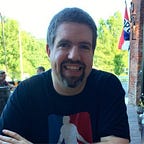“There is No Formula to Our Music”: The Making Of Daft Punk’s “Discovery”
In an era where inundating the public with personal information is the norm for celebrities and non-celebrities, Daft Punk is a breath of fresh air. Though the duo’s real life identities Thomas Bangalter and Guy-Manuel de Homem-Christo are widely known now, they’ve generally kept a low profile through the use of futuristic masks and costumes despite being a globally recognized band. Rolling Stone hailed their 1997 release Homework the “Greatest EDM Album of All Time” and ranked 2001’s Discovery #8 on the same list — yet most people couldn’t identify either member of Daft Punk in a lineup. Over the years they’ve turned themselves into near mythical cult heroes by rejecting celebrity culture and rarely granting interviews, often letting their music speak for itself.
When the mysterious duo set out to create 2001’s Discovery, the stakes were high after the group made waves with their debut effort four years prior. Despite harsh reviews from a few famed critics, 1997’s Homework had been a significant commercial and critical success at the time of its release.
After Homework caught fire with audiences all around the world, Daft Punk spent much of 1998 touring while 1999–2000 was split between solo/side projects and group work. By the time they put the finishing touches on Discovery, they found they’d reached a new level of musical maturity. If Homework was “a manifesto for electronic music at the time and a rough and raw thing” — as they described it in a 2001 interview with MTV — Discovery showcased greater diversity in texture, structure, and other subtleties, without sounding overly polished and sterile.
“There is no formula to our music.” — Thomas Bangalter
Along with a more advanced sound, many music critics were quick to point out similarities to music from the 70s and 80s. When asked about this, Bangalter insisted that Discovery was more about capturing a time of innocence and wonder as a music fan than paying tribute to specific decades in music. “It’s about our personal relationship to that time,” he said in a 2001 interview with Remix magazine “It’s less of a tribute to the music from 1975 to 1985 as an era, and more about focusing on the time when we were zero to ten years old.”
In making the appropriately named Discovery, the group sought to pay homage to that that magical decade in people’s lives when their musical tastes are more open to raw emotions and childlike wonder. To capture this state of mind, Daft Punk enlisted the help of Romanthony, DJ Sneak, and Todd Edwards as co-writers and co-producers on several songs.
In addition to seeking assistance and insight from their peers, Discovery also moved away from a sample-heavy model often found in electronic music. Although the group utilized vintage samplers like the E-mu SP-1200, Akai MPC, and even an early version on Logic for sequencing, they actually used very few samples taken directly from vinyl records.
“It’s less of a tribute to the music from 1975 to 1985 as an era, and more about focusing on the time when we were zero to ten years old.” — Thomas Bangalter
Multiple debates have since raged online about the number of actual samples used on Discovery, but the group maintained in their Remix magazine interview that only three samples were utilized. According to Daft Punk, they often replayed and interpolated samples — later sampling their own recreated music and further altering the sounds. (In an interesting aside, Vibe reported in 2014 that “One More Time” did in fact use a legally licensed sample of Eddie Johns’ “More Spell On You”, something the group previously denied.)
Contrary to the often furious release schedules of artists today, Daft Punk seemed to embrace the “you can’t rush art” philosophy while working on the album. According to a Pitchfork interview, Discovery’s smash hit “One More Time” was finished and mixed in 1998 before making its way onto the album three years later. It seems the group still moves at their own pace many years later — they started working on Random Access Memories in 2008 before finally releasing it in 2013.
Though Homework may remain a favorite for some fans and Rolling Stone, Discovery has left a longer lasting imprint our collective consciousness. “One More Time” remains a transcendent hit — arguably the group’s biggest — that has been included in several “Best of All Time” lists for major music publications. Further broadening the album’s audience and reach, legendary anime and Manga artist Leiji Matsumoto supervised the creation of an animated film titled Interstella 5555: The 5tory of the 5ecret 5tar 5ystem in 2003 as a visual accompaniment to Discovery. And Kanye West famously sampled “Harder, Better, Faster, Stronger” for his 2007 song “Stronger”, bringing Daft Punk back into the public eye after their Grammy performance alongside Kanye.
When asked to describe their work flow in 2001, Bangalter told Remix, “It’s pretty wide open. There is no formula to our music.” Though Daft Punk may continue to evolve and refine their process, it seems like that underlying philosophy remains the same today. Perhaps that’s the reason why so many of us care far more about their music than their real life identities.
Connect with Daft Punk on Facebook, Instagram, their website, and on Twitter @daftpunkstore.
If you enjoyed this piece, please consider following my Bookshelf Beats and Micro-Chop publications or donating to the Micro-Chop Patreon page. You can also read my work at HipHopDX.
